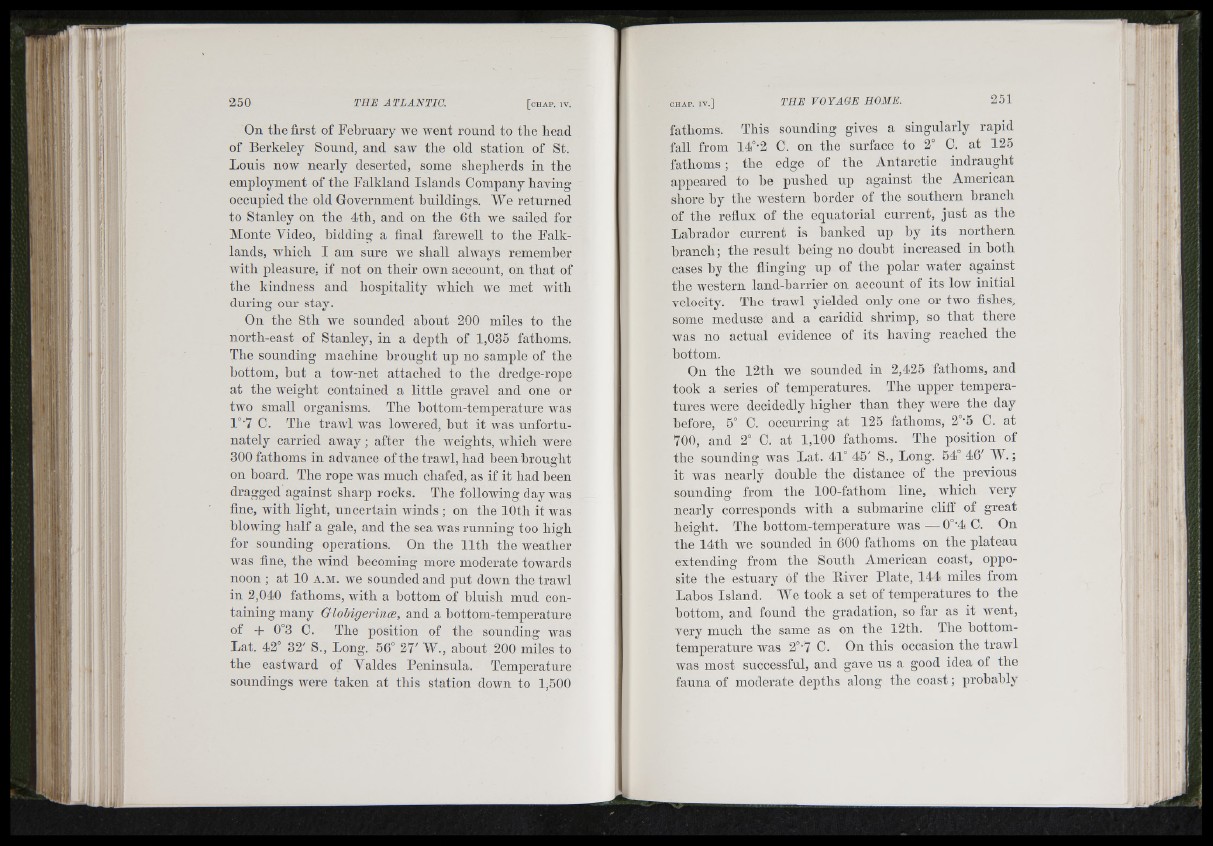
Ì h
Aiil
On the first of February we AA'ent round to the head
of Berkeley Sound, aud saw the old station of St.
Louis now nearly deserted, some shepherds in the
employment of the Falkland Islands Company having
occupied the old Government huildings. We returned
to Stanley on the Ith , and on the Gth we sailed for
Monte Video, bidding a final farcAvell to the Falk-
lauds, Avhicli I am sure Ave shall ahvays remember
AA'ith pleasure, if not on their oavu account, on th a t of
the kindness and hospitality which Ave met with
during our stay.
On the 8th we sounded about 200 miles to the
north-east of Stanley, in a depth of 1,035 fathoms.
The sounding machine brought up no sample of the
hottom, hut a toAv-net attached to the dredge-rope
at the weight contained a little gravel aud one or
two small organisms. The hottom-temperature Avas
1°'7 C. The trawl Avas loAvered, b u t it Avas unfortunately
carried aw'ay ; after the aveights, Avhich were
300 fathoms iu advance of the traAvl, had been brought
on board. The rope was much chafed, as if it had been
dragged against sharp rocks. The following day was
fine, with light, uncertain winds ; on the 10th it was
blowing half a gale, and the sea was running too high
for sounding operations. On the 11th the Aveather
Avas hue, the AA'ind becoming more moderate towards
noon ; at 10 a .m . avc sounded and p u t doAvu the trawl
in 2,040 fathoms, Avith a hottom of bluish mud containing
many Globigerince, and a hottom-temperature
of + 0°3 C. The position of the sounding was
Lat. 42° 32' S., Long. 56° 27' W., ahout 200 miles to
the eastward of Valdes Peninsula. Temperature
soundings were taken at this station down to 1,500
fathoms. This sounding gives a singularly rapid
fall from 14°-2 C. on the surface to 2° C. at 125
fathoms ; the edge of the Antarctic indraught
appeared to be pushed up against the American
shore hy the AA'estern border of the southern branch
of the reflux of the equatorial current, ju s t as the
Labrador current is hanked up hy its northern
hranch; the result heing no doubt increased in both
cases hy the flinging up of the polar water against
the western land-harrier on account of its low initial
velocity. The trawl yielded only one or two fishes,
some medusse and a caridid shrimp, so th a t there
Avas no actual evidence of its having reached the
bottom.
On the 12th we sounded in 2,425 fathoms, and
took a series of temperatures. The upper temperatures
Avere decidedly higher th an they Avere the day
hefore, 5° 0. occurring at 125 fathoms, 2°‘5 C. at
700, and 2° C. at 1,100 fathoms. The position of
the sounding Avas Lat. 41° 45' S., Long. 54° 46' W. ;
it was nearly double the distance of the previous
sounding from the 100-fathom line, Avhicli very
nearly corresponds with a submarine cliff of great
height. The hottom-temperature was — 0°‘4 C. On
the 14th we sounded in 600 fathoms on the plateau
extending from the South American coast, opposite
the estuary of the River Plate, 144 miles from
Lahos Island. MY took a set of temperatures to the
bottom, and found the gradation, so far as it Avent,
very much the same as on the 12th. The hottom-
temperature Avas 2°’7 C. On this occasion the trawl
Avas most successful, and gave ns a good idea of the
fauna of moderate depths along the coast ; probably